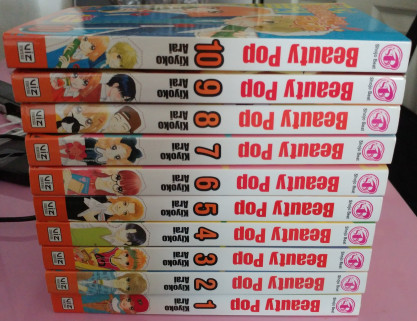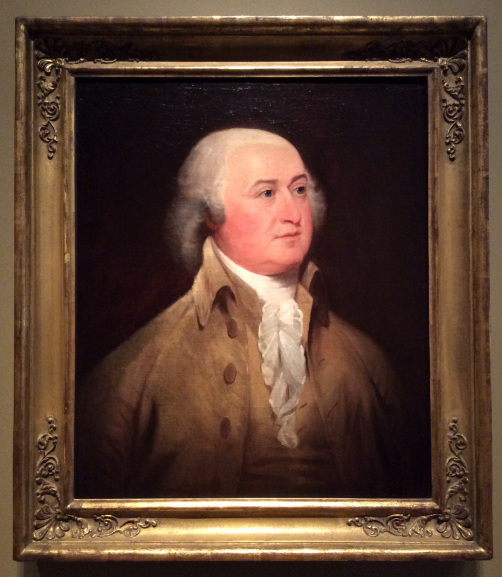Back in my teenage years, I was a big-time manga collector, and now, in my twenties, I still have shelves full of different volumes and series. While my anime preferences trend more toward the action-based/sci-fi/fantasy/mecha titles, like Neon Genesis Evangelion, Wolf’s Rain, Inuyasha, Attack on Titan, Last Exile, and Cowboy Bebop, my manga tastes stray more toward the “girly” fare. And one such series is Beauty Pop by Kiyoko Arai, which ran from 2003-2008 and was completed at 10 volumes.
I read Beauty Pop quite a few years ago, and all I remember is that it’s about cutting hair and I thought it was hilarious. Also, the lead female was a bit unconventional for a shojo title. But that’s all I’ve got, so it’s time for a reread!
~READING BREAK~
Alright! I initially planned on reading just the first 3 volumes for this post, but ended up powering through all 10 because I got sucked in, just like I did when I read it all those years ago. Beauty Pop follows 1st year high-schooler Kiri Koshiba, a girl with a gift for hair-styling, and her interactions with the S.P., or Scissors Project, a club run by 2nd year Shogo Narumi and his friends Kazuhiko Ochiai and Kei Minami, who are determined to be the top makeover/stylist team in Japan. Naturally, many hair-related hi-jinks ensue.
 Overall, the series has a nice, meandering pace; there are over-arcing stories that run through the course of the series, but also several smaller, more episodic narratives that unfold in conjunction with the major plot-lines, and they are well balanced, so the story never loses the flow. A couple of the side stories kind of fall flat, but overall, the narrative is charming and engaging. The character relationships are also handled exceptionally well; there is as much, if not more, focus on friendship between the main cast (Kiri and her best friend Kanako get a nice subplot, Ochiai and Narumi have a lot going on, and lots of minor characters who encounter the S.P. have interesting and relatable issues to face) than there is on the romance. Typical “real world, growing up” problems are also handled and touched upon quite a lot, as the characters grapple with decisions that will impact their futures, their relationships with family, their education, and their ties to friends. The more romantic elements are hinted at and briefly explored in the early volumes, but don’t really progress until the last 3, so it isn’t the main draw of the plot. This is not the standard, but the plot of the manga is definitely more focused on the comedy/slice of life/coming of age stories, which is a nice change in tone from more “dramatic” titles in this genre. Plus, the emphasis on hair-styling/makeup is intriguing, as it allows for exploration into personal ideas of beauty and the way society looks at people versus how they should be seen.
Overall, the series has a nice, meandering pace; there are over-arcing stories that run through the course of the series, but also several smaller, more episodic narratives that unfold in conjunction with the major plot-lines, and they are well balanced, so the story never loses the flow. A couple of the side stories kind of fall flat, but overall, the narrative is charming and engaging. The character relationships are also handled exceptionally well; there is as much, if not more, focus on friendship between the main cast (Kiri and her best friend Kanako get a nice subplot, Ochiai and Narumi have a lot going on, and lots of minor characters who encounter the S.P. have interesting and relatable issues to face) than there is on the romance. Typical “real world, growing up” problems are also handled and touched upon quite a lot, as the characters grapple with decisions that will impact their futures, their relationships with family, their education, and their ties to friends. The more romantic elements are hinted at and briefly explored in the early volumes, but don’t really progress until the last 3, so it isn’t the main draw of the plot. This is not the standard, but the plot of the manga is definitely more focused on the comedy/slice of life/coming of age stories, which is a nice change in tone from more “dramatic” titles in this genre. Plus, the emphasis on hair-styling/makeup is intriguing, as it allows for exploration into personal ideas of beauty and the way society looks at people versus how they should be seen.
For example, in one bit, Kiri gets blamed for something that happens to the S.P. club room after she winds up in the wrong place at the wrong time, and instead of immediately assuming that she did it and getting angry, Narumi asks her about it, she says she didn’t do it, and he believes her. I half expected him to fly off the handle and go on a total rage campaign against her in a fit of manufactured drama, but no – she says she didn’t do it, and he accepts her word. It’s a great way to show how their relationship has grown to that point, and to subvert some familiar tropes of the genre.
Beauty Pop is also more of an ensemble effort than it is focused solely on one character. Some get more page-time than others (Kei, for example, doesn’t get any chapters where he is the main focus, and neither do Iori and Seki) but most of the characters get a fair amount of development and show real growth over the series. This allows for a greater range of stories to be told, as readers glean insight into Narumi’s confrontational relationship with his father, Ochiai’s ambitions clashing with his personal relationships, Kiri’s personal history with hair-styling, Kanako’s struggles to juggle friendship and love, and Billy’s difficulty choosing between duty and family.
Also, the art is great; it isn’t flashy, but the characters all have a unique style, and there isn’t anything too distracting that draws away from the story. All the different hair-styles are also cool to see, as Kiri and Narumi work their magic on a plethora of side-characters.
As I remembered, Kiri is definitely an unconventional shojo heroine, which makes this series stand out from several others. She has a laid-back, generally aloof personality that clashes spectacularly with her high-strung, temperamental counterpart, Narumi. She’s hilarious, a real breath of fresh air, and a good chunk of her story focuses on past trauma and whether she truly wants to be a beautician, and her struggles coming to terms with her dreams and her past. My only quibble with Kiri as the heroine is that, when the inevitable love triangle rears its head, you don’t get much of her perspective, especially in the later volumes. However, on the flip side of that, there is a lot of emphasis put on the two male characters of the triangle, which, at least in my experience with manga, goes a bit against the grain. But, since Kiri’s thoughts on the matter are barely touched upon, the ending doesn’t pack quite enough emotion as I would have hoped for. But in terms of the general “building up” of the romance over the course of the volumes, the progression is subtle for the most part. Narumi’s initial derision for Kiri fades slowly as they learn more about one another and gradually start to work together, but their interactions develop in a way that feels organic and natural. Ochiai’s blossoming crush on Kiri has an impact on his friendship with Narumi, as he mainly struggles with his budding feelings on his own until the triangle reaches a climax, though Kiri and Kanako’s friendship does suffer a minor snag once Ochiai’s motivations become more clear. So, although the triangle is such an overdone trope, it doesn’t feel hastily thrown in; most sides get a fair amount of development, but I wish we could have had more of Kiri’s perspective. I will say, now, as an adult, some of the “romance” comes across as more “stalkery” or “cringey,” but isn’t really presented as such. Then again, maybe I’m just out of touch.
When I first read Beauty Pop as a teenager, I was drawn in by the comedy and the unusual focus on hair-styling and beauty, and now, all these years later, that allure still rings true. I didn’t laugh quite as much as I did, but I was still drawn in by the story and the characters. It’s a light-hearted title that presents familiar tropes in an unconventional and unexpected fashion, breathing new life into a genre that can easily get stale.
Shameless plug: My book tour for my YA novel, I’m With You, is still ongoing! Check it out here: LINK! Plus, the ebook is only $1.99 or (£1.55) on Amazon / Amazon UK.
Advertisements Share this:





